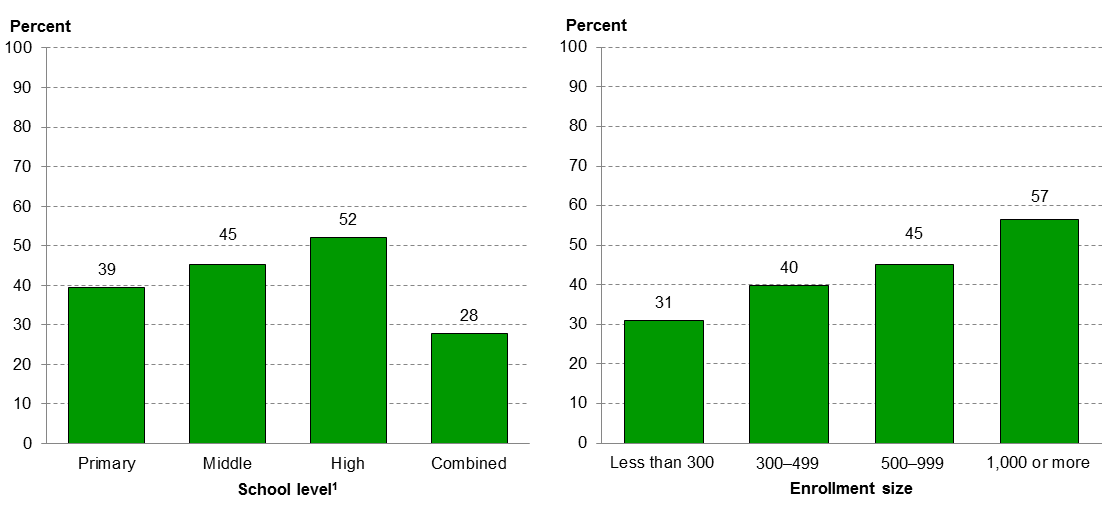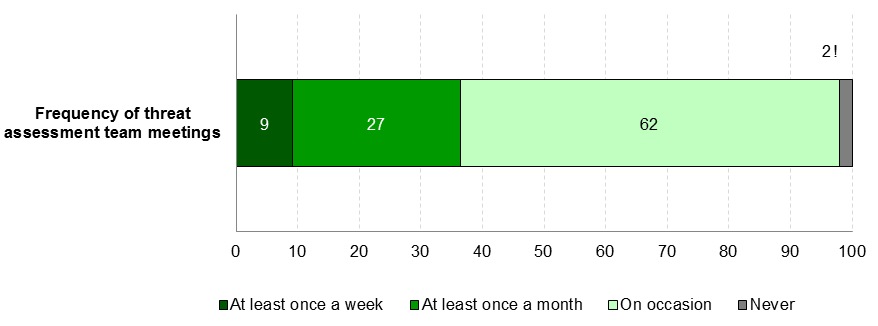As part of the Safe School Initiative, the U.S. Department of Education and U.S. Secret Service authored a report in 2004 that described how schools could establish a threat assessment process “for identifying, assessing, and managing students who may pose a threat of targeted violence in schools.” School-based threat assessment teams are intended to prevent and reduce school violence and are adapted from the U.S. Secret Service’s threat assessment model.
The School Survey on Crime and Safety (SSOCS) collected data on the prevalence of threat assessment teams in schools for the first time in 2015–16 from a nationally representative sample of 3,500 K–12 public schools. The questionnaire defined a threat assessment team as “a formalized group of persons who meet on a regular basis with the common purpose of identifying, assessing, and managing students who may pose a threat of targeted violence in schools.” School-based threat assessment teams are usually composed of some combination of school administrators, teachers, counselors, sworn law enforcement officers, and mental health professionals.
While 42 percent of all public schools reported having a threat assessment team during the 2015–16 school year, the prevalence of threat assessment teams varied by school characteristics.
Percentage of public schools that reported having a threat assessment team, by school level and enrollment size: School year 2015–16

1Primary schools are defined as schools in which the lowest grade is not higher than grade 3 and the highest grade is not higher than grade 8. Middle schools are defined as schools in which the lowest grade is not lower than grade 4 and the highest grade is not higher than grade 9. High schools are defined as schools in which the lowest grade is not lower than grade 9 and the highest grade is not higher than grade 12. Combined schools include all other combinations of grades, including K–12 schools.
NOTE: A threat assessment team was defined for respondents as a formalized group of persons who meet on a regular basis with the common purpose of identifying, assessing, and managing students who may pose a threat of targeted violence in schools. Responses were provided by the principal or the person most knowledgeable about school crime and policies to provide a safe environment. Although rounded numbers are displayed, the figures are based on unrounded estimates.
SOURCE: U.S. Department of Education, National Center for Education Statistics, 2015–16 School Survey on Crime and Safety (SSOCS), 2016. See table 35.
For example, a higher percentage of high schools (52 percent) than of middle (45 percent), primary (39 percent), and combined schools (28 percent) reported having a threat assessment team during the 2015–16 school year. Further, 57 percent of schools with an enrollment size of 1,000 or more students reported having a threat assessment team, compared with 31 percent of schools with an enrollment size of less than 300 students; 40 percent of schools with an enrollment size of 300–499 students; and 45 percent of schools with an enrollment size of 500–999 students.
Threat assessment teams were also more prevalent in schools that had at least one security staff[i] member present at school at least once a week during the 2015–16 school year (48 percent of schools with security staff present vs. 33 percent of schools without security staff present). The percentage of schools reporting a threat assessment team was also higher in schools that reported at least one violent incident[ii] had occurred at school during the 2015–16 school year (44 percent) compared with schools that had no violent incidents (35 percent).
How often a threat assessment team meets can be an indication of how active the team is in the school. The majority of schools with a threat assessment team in 2015–16 reported that their teams met “on occasion” (62 percent), followed by “at least once a month” (27 percent), “at least once a week” (9 percent), and “never” (2 percent).
Among public schools that reported having a threat assessment team, percentage distribution by frequency of threat assessment team meetings: School year 2015–16

!Interpret data with caution. The coefficient of variation (CV) for this estimate is between 30 and 50 percent.
NOTE: A threat assessment team was defined for respondents as a formalized group of persons who meet on a regular basis with the common purpose of identifying, assessing, and managing students who may pose a threat of targeted violence in schools. Responses were provided by the principal or the person most knowledgeable about school crime and policies to provide a safe environment.
SOURCE: U.S. Department of Education, National Center for Education Statistics, 2015–16 School Survey on Crime and Safety (SSOCS), 2016. See table 35.
You can find more information on school crime and safety in NCES publications, including Crime, Violence, Discipline, and Safety in U.S. Public Schools: Findings From the School Survey on Crime and Safety: 2015–16 and the 2017 Indicators of School Crime and Safety.
By Rachel Hansen, NCES and Melissa Diliberti, AIR
[i] Security staff includes full- or part-time school resource officers, sworn law enforcement officers, or security guards or security personnel present at school at least once a week.
[ii] Violent incidents include rape or attempted rape, sexual assault other than rape (including threatened rape), physical attack or fight with or without a weapon, threat of physical attack with or without a weapon, and robbery (taking things by force) with or without a weapon.